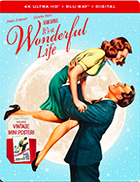It's a Wonderful Life (4K Steelbook)
|  Frank Capra’s It’s a Wonderful Life has one of those great histories that belies its seeming omnipresence in cinema history. A dud in theaters when first released in 1946, it was confined to obscurity for years before falling into the public domain and being used by PBS stations as December counter-programming during the 1970s, after which time it became—and remains—a holiday classic. Along with stockings hung by the fireplace, decorated trees, and blinking lights on the house, the viewing of this movie has become indelibly interwoven into contemporary Christmas tradition. Quite appropriately, the movie started as a Christmas card. In the early 1940s, writer Philip Van Doren Stern penned a short story called “The Greatest Gift,” which he printed on 200 holiday cards and sent out to friends and family. RKO Pictures bought the story a few years later for $10,000, and after three writers couldn’t make it work, sold it to Capra. Capra reworked the three existing screenplays—incorporating what he liked and adding new characters—and the rest is history. People tend to think of It’s a Wonderful Life as a feel-good movie because of that happy, Christmas ending—George Bailey (James Stewart) running down the streets of Bedford Falls, a picture-perfect slice of small town Americana, yelling “Merry Christmas!” to anyone and everyone, all because an angel named Clarence Oddbody (Henry Travers) has just shown him that he has, indeed, lived a wonderful life. But, what many people seem to forget (or perhaps consciously ignore) is the darkness that pervades the first hour and forty minutes of the film. Until Clarence arrives on the scene to show how mistaken George is when he laments, “It would be better if I had never been born,” Capra takes us along the painful journey that drove George to make such a statement. That the movie opens on a dark night with swirling snow, filled with the disembodied, echoing, and sad voices of characters yet to be introduced praying intently for God’s help is a strong indicator of what the movie has in store. Most of the movie concentrates on the systematic crushing of a succession of George’s dreams. As a young man, he dreams of “shaking the dust of this crummy little town” off his feet and going to see the world. However, the day before he is set to leave on a European trip before entering college, his father dies. George sacrifices the trip to Europe in order to straighten out his father’s business, the tiny Building & Loan that is the only business in Bedford Falls not run by Mr. Potter (Lionel Barrymore), a malicious, crooked, Scrooge-like businessman who is introduced by a character’s remarking that he is “the richest and meanest man in the county.” George is then forced to postpone college in order to run the Building & Loan, a job that he had earlier remarked to his father he could never do. He gives his college money to his younger brother Harry, who goes to school, gets married, and doesn’t take over the Building & Loan upon graduation as George had expected. George stumbles into marriage with the beautiful and patient Mary (Donna Reed) and eventually starts a family, all of which further ties him to the town he had so desperately wanted to leave. Even his honeymoon, his last chance to see the world, is canceled because he is forced to use the $2,000 he had saved to avoid a run on the Building & Loan and protect it from bankruptcy. The final straw occurs when George’s partner, his Uncle Billy (Thomas Mitchell), misplaces $8,000 of the Building & Loan’s money. The money falls into Mr. Potter’s hands on the same day that the bank inspector is checking the Building & Loan’s books. Unable to balance the books, George faces not only bankruptcy, but public humiliation and criminal liability that could land him in jail. With only a $15,000 life insurance policy to his name, George stands drunkenly on a bridge late at night, contemplating drowning himself, when Angel Second Class Clarence Oddbody intervenes. What happens then is a sort of reworking of Charles Dickens’s A Christmas Carol, with Clarence taking George on a tour of the alternate reality of Bedford Falls (now called Pottersville because Potter owns everything) that would have existed had George never lived. As critic Robin Wood pointed out in an excellent analysis of the film, this portion of It’s a Wonderful Life is invaded with a “disturbing influx” of film noir—if Bedford Falls was a place of small-town comedy, then Pottersville is a seedy, dark underworld of strip clubs, neon lights, and prostitutes. This vision alone is enough to convince us of Capra’s ultimate theme: that everyone’s life is worth something. That Harry would have drowned at age 9 if George hadn’t saved him; that the pharmacist George worked for as a boy would have gone to jail for accidentally poisoning people had George not noticed his mistake; and that his wife would have turned into a lonely, miserable spinster had he not married her (a bit of badly dated sexism, but we’ll let it slide) is all further testament to the importance of George’s very existence. After the bleakness of the opening passages (enlightened at times by light-hearted comedy, but still bleak in the overall), It’s a Wonderful Life concludes with a Hollywood happy ending that is traditional on its surface, but still subversive. The fact that George realizes the importance of his life, that he goes home and embraces the family he had earlier cursed, and that the community around him, which he had spent his entire life helping, swells to his assistance, are all part of the Capraesque quality of the conclusion (often derided as “Capracorn”), thus reaffirming faith in traditional American values (family, community, capitalism). Yet, there are still nagging questions left unanswered that perhaps reflect the more somber and disillusioned mood of America in the post-World War II years. Remember that Mr. Potter never gets what’s coming to him, as he most certainly would have in most classic Hollywood pictures; in fact, in stark contrast to being punished, he presumably makes off with the missing $8,000 and continues to own most of Bedford Falls. And, despite George’s embracing of the life he has already led, it is still hard to dispel that twinge of sadness that he never got to lead the life he had truly wanted. Although at the end he finally finds happiness with the hand he has been dealt, It’s a Wonderful Life is still a film about broken dreams. However, the message at the end is that some of the best things in life are the one we never dream about—broken dreams can be a blessing. This is part of the reason why It’s a Wonderful Life is so immanently watchable. It is a truly classic, timeless film, one of the few that quite simply never grows old. Capra weaves a rich tapestry of American life on the screen, filling each frame with numerous tiny details that are often overlooked (note that creepy-looking skull that stares at the audience from the edge of Mr. Potter’s desk). It also features wonderful performances from James Stewart, in his first role after returning from duty in World War II, and from Donna Reed, then an unknown contract player. In fact, the best scene in the movie takes place between them. The action transpires in Mary’s house, where she and George are listening to a high school friend on the phone at the same time. As they stand close together, sharing the receiver, we gradually realize that George is finally falling in love with Mary, something he had been trying to avoid. They stand side-by-side, Mary facing forward, pretending to listen to the phone, but all-too conscious of George right next to her, smelling her hair, his trembling lips just inches from her brow. Stewart and Reed are simply marvelous in their eye movements and facial expressions; the scene is intimate, moving, and incredibly sensual, perhaps one of the best cinematic renditions of the actual dawning of love. And, the fact that the scene goes from uncomfortable, to tender, to suddenly violent, to tender again without missing a beat is but one more example of how complex and unexpected It’s a Wonderful Life truly is. Nobody could have done it better, which makes it all the more fascinating that this extraordinary scene, which Stewart was nervous about filming and which left out an entire page of scripted dialogue, was done in a single take. That’s the magic of the cinema.
Copyright © 2020 James Kendrick Thoughts? E-mail James Kendrick All images copyright © Paramount Home Entertainment | |||||||||||||||||||||||||||||
Overall Rating: 


 (4)
(4)


